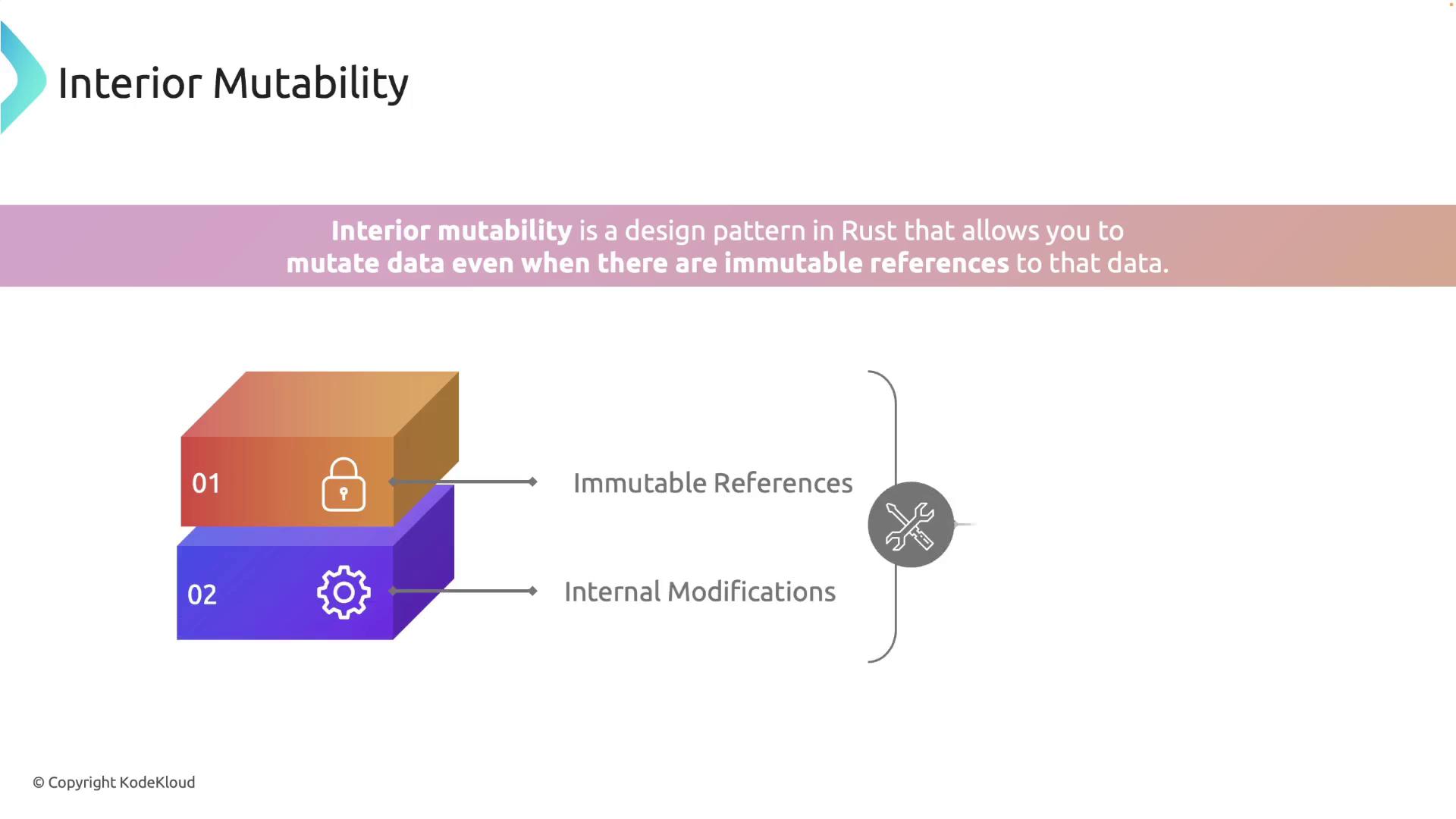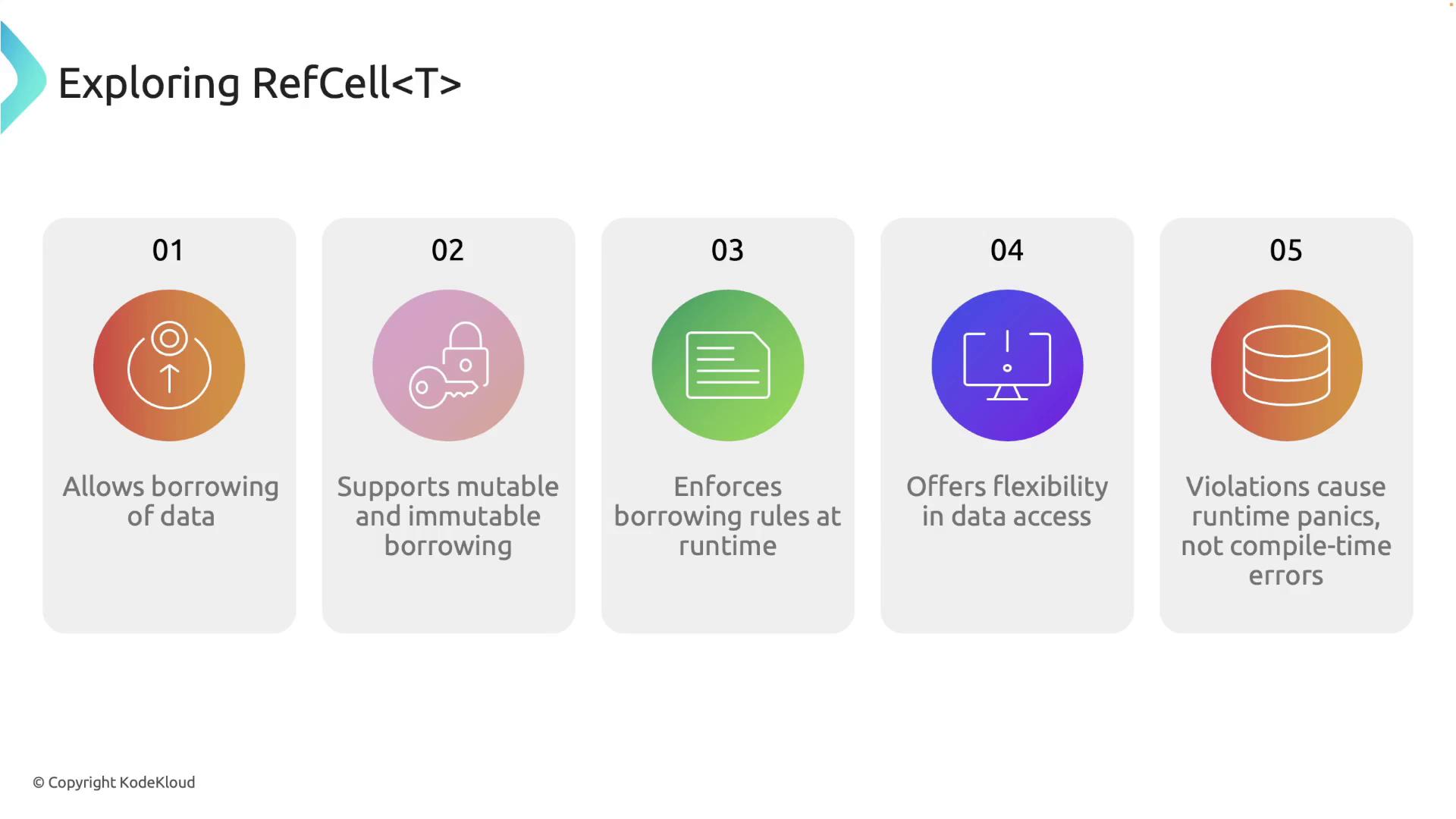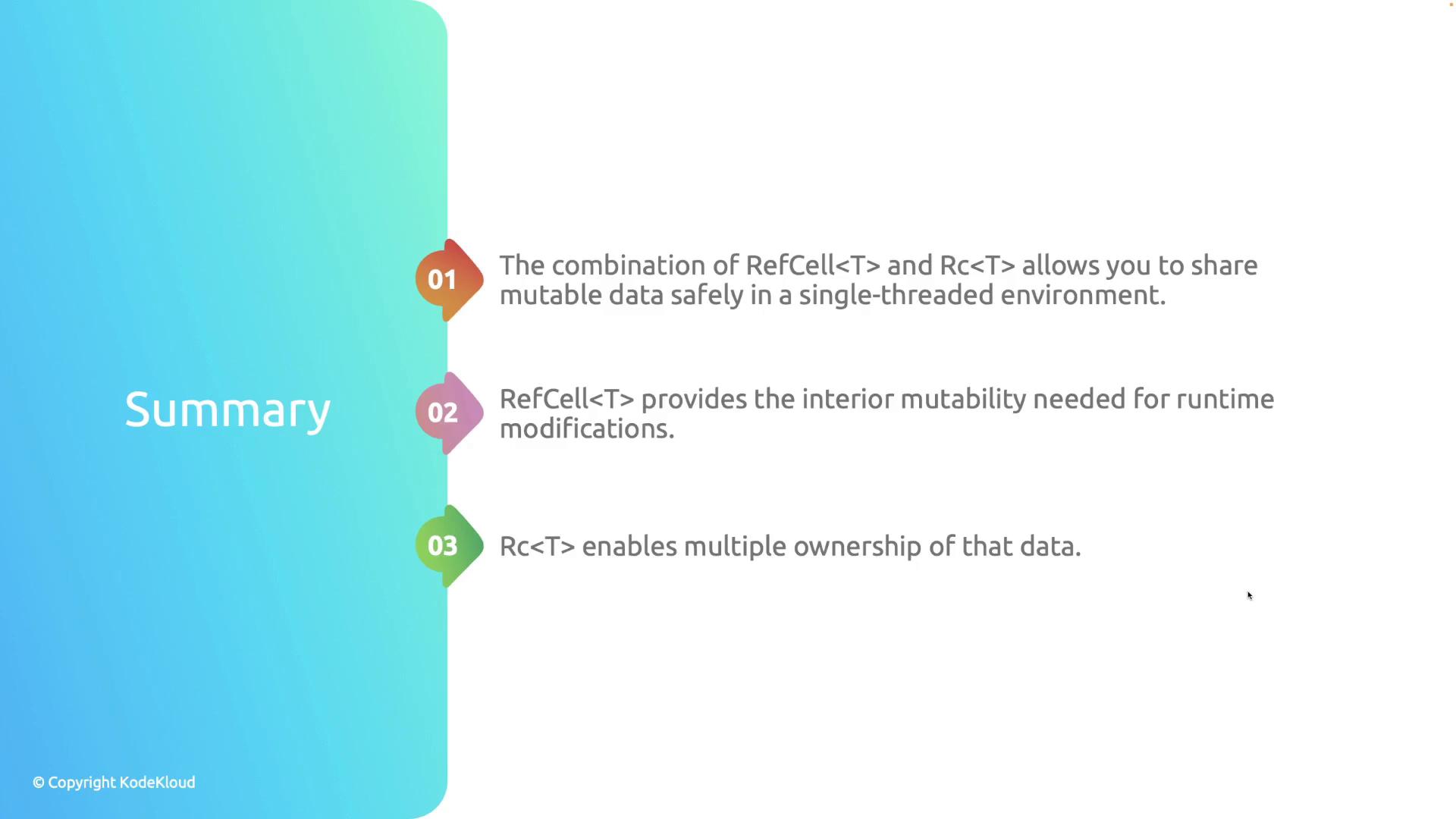Rust Programming
Advanced Rust Concepts
RefCell and Interior Mutability
In this lesson, we explore the concept of RefCell and interior mutability in Rust—key features that allow you to modify data behind immutable references while still ensuring memory safety.
Rust strictly enforces borrowing rules to prevent data races and ensure safety. Typically, a variable can either have multiple immutable references or one mutable reference at a time. However, situations arise where modifying data is necessary even when only immutable references are available. This technique, known as interior mutability, enables you to achieve that flexibility. The RefCell<T> type is widely used for this purpose as it dynamically enforces borrowing rules at runtime instead of compile time.

With RefCell<T>, you can bypass several compile-time restrictions. While Rust enforces borrowing rules during compilation, RefCell<T> shifts these checks to runtime. If conflicting borrows occur, the program will panic rather than fail to compile. This runtime check delivers additional flexibility, though it comes with the risk of panics if the rules are violated.
Understanding Interior Mutability
Interior mutability is especially beneficial when you want to maintain an API that seems immutable externally while still allowing internal state changes. This approach is ideal for scenarios where a value needs dynamic updates despite numerous immutable references.

Understanding RefCell
RefCell is a smart pointer that encapsulates data and provides methods for both mutable and immutable borrowing—namely, the borrow_mut and borrow methods. Unlike standard references that enforce borrowing rules during compile time, RefCell performs these checks at runtime. Consequently, if two parts of your code attempt conflicting borrows simultaneously, the program panics at runtime.

A Practical Example with ConfigManager
Imagine a system with various components that share access to a central configuration object. This configuration might include details like the database URL, maximum connections, or timeout values. Although multiple parts of the program might only need to read the configuration, there are times when it must be updated dynamically. With RefCell, you can update parts of the configuration without requiring the entire configuration object to be mutable.
Below is an example implementation that demonstrates how RefCell allows interior mutability through a ConfigManager struct.
use std::cell::{RefCell, RefMut};
struct ConfigManager {
database_url: RefCell<String>,
max_connections: RefCell<u32>,
}
impl ConfigManager {
// Constructor that initializes the configuration
fn new(database_url: &str, max_connections: u32) -> Self {
Self {
database_url: RefCell::new(String::from(database_url)),
max_connections: RefCell::new(max_connections),
}
}
// Updates the database URL using a mutable borrow
fn update_database_url(&self, new_url: &str) {
let mut url: RefMut<String> = self.database_url.borrow_mut();
*url = String::from(new_url);
}
// Updates the maximum connections using a mutable borrow
fn update_max_connections(&self, new_max: u32) {
let mut max: RefMut<u32> = self.max_connections.borrow_mut();
*max = new_max;
}
// Prints the current configuration using immutable borrows
fn print_config(&self) {
println!("Database URL: {}", self.database_url.borrow());
println!("Max Connections: {}", self.max_connections.borrow());
}
}
fn main() {
// Create an instance of ConfigManager with initial configuration
let config: ConfigManager = ConfigManager::new("localhost:5432", 10);
// Print the initial configuration
config.print_config();
// Update configurations dynamically without the instance itself being mutable
config.update_database_url("localhost:5433");
config.update_max_connections(20);
// Print the updated configuration
config.print_config();
}
In this example, the ConfigManager struct uses RefCell to wrap its fields, allowing internal state modifications via the borrow_mut method—despite the instance being immutable. This design is particularly useful when exposing an immutable interface while still permitting internal adjustments.
Combining Rc and RefCell for Shared Mutable Data
In single-threaded scenarios, it is common to combine RefCell with Rc (Reference Counted pointer) to allow multiple parts of your program to share ownership of mutable data. While Rc<T> facilitates multiple owners, it normally guarantees only immutable access. By combining it with RefCell<T>, you can safely enable shared mutable state.
Consider the following example, which demonstrates how Rc and RefCell work together:
use std::cell::{RefCell, Ref, RefMut};
use std::rc::Rc;
struct Config {
setting: RefCell<String>,
}
fn main() {
// Create a new configuration instance wrapped in Rc and RefCell
let config: Rc<Config> = Rc::new(Config {
setting: RefCell::new(String::from("Initial setting")),
});
// Clone the Rc pointer to simulate multiple owners
let module_a: Rc<Config> = Rc::clone(&config);
let module_b: Rc<Config> = Rc::clone(&config);
// Module A modifies the configuration
{
let mut setting: RefMut<String> = module_a.setting.borrow_mut();
*setting = String::from("Module A changed this setting");
}
// Module B reads the modified configuration
{
let setting: Ref<String> = module_b.setting.borrow();
println!("Module B sees: {}", setting);
}
// The original reference reads the modified configuration
{
let setting: Ref<String> = config.setting.borrow();
println!("Original config sees: {}", setting);
}
}
In this code sample, the Config instance contains a setting wrapped in RefCell. By wrapping the Config instance in Rc, multiple modules—Module A and Module B—can share ownership. Module A updates the setting using borrow_mut, and Module B, along with the original reference, reads the updated value using borrow.
cargo run --quiet
Module B sees: Module A changed this setting
Original config sees: Module A changed this setting

Summary
RefCell and interior mutability offer the power to perform runtime borrowing checks and manage dynamic data modifications while maintaining immutable interfaces. This approach is particularly effective when used alongside Rc to enable safe and shared mutable state in single-threaded environments. Whether for dynamic configuration management or other scenarios requiring shared mutable state, mastering RefCell and its combination with Rc is invaluable.
Next, we will delve into managing reference cycles using weak smart pointers to prevent memory leaks in complex systems with shared ownership.
For more information, visit the Rust Documentation and explore related topics.
Further Reading
To expand your understanding of Rust's memory safety features, check out additional guides on smart pointers and ownership.
Watch Video
Watch video content